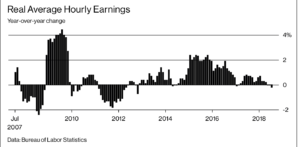
Image: guardiandebtrelief.com
Worker pay continues to stagnant. Yet, companies are raising prices. The price increases are due to tariff based supplier cost increases and government tax credits juicing the economy. The Federal Reserve survey for July in the Philadelphia area showed that manufacturers plan on raising prices by 3 % versus 2 % last year.

Source: HIS Markit, Bloomberg – 8/28/18
How did companies get this pricing power? Corporations have received a $1 trillion tax cut, reduced regulations by the Trump administration, less oversight by the EPA, and less scrutiny on mergers. Companies are at the zenith of their power allowing them to raise prices, keep wages low – below inflation, while increasing profits and executive compensation.

Source Bureau of Labor Statistics, Bloomberg – 8/24/18
Worker economic power continues to wane, as real wages actually turned negative this past month. Worker share of income as a percentage of non-farm business income is at a 70-year low even in a strong economy.

Source: Bureau of Labor Statistics, Bloomberg Businessweek, The Wall Street Journal, The Daily Shot – 8/27/18
How are consumers handling the budget shortfall? By borrowing, the debt as a percentage of income of the bottom 80 % is 4 times the debt of the top 20 %.

Most of this debt is in the form of credit card, auto loans and home equity lines of credit. Home owners have done a better job keeping their first mortgages in line with incomes this year versus the housing bubble of 2008.
Next Steps:
Caught between high prices and flat real wages, consumers are filling the budget gap by piling on debt. Companies are getting even richer from both sides of making a profit – increasing income by raising prices and reduced costs by keeping worker wages low.
Why is this vise tightening on worker budgets? Corporations are accumulating power every day at an ever increasing rate; buying other companies, issuing stock backs to hype stock price, increasing lobbying budgets to get the federal government to make rules that tip their way, consolidating supply channels, distributing manufacturing world-wide and automating every job they can conceive be done by a robot. Prices are rising due to tariffs in many industries, the wide spread use of tariffs on some consumer goods, contagion of one product category to another (tit for tat) and shrinking channels of distribution reducing price competition.
Meantime, workers continue to lose power at even faster rate than corporations gain power. Wages have been stagnant for 20 years for the bottom 80 % in income. We have outlined in previous posts why wages have actually declined – rise of corporate power, fewer unions, automation, mergers in the same industry reduce the overall number of jobs, increased availability of candidates over the Internet, outsourcing, and the gig economy. Workers are getting some relief in the gig economy with lawsuits to recognize Uber drivers as employees, but it is a tough long slog through the courts. Overall, most court decisions are favoring companies in reducing union power, allowing companies to give millions to campaigns unchecked (Citizens United case) and overtime pay.
Eventually prices will rise too high for declining incomes causing consumer spending to fall. Consumer spending has been falling this year, with the most recent decline announced today, as a revised downward revision to 3.8 % in 2nd quarter.

Sources: BEA, Factset – 6/1/18
Remember, corporate executives are compensated handsomely for what? Making more profit by increasing income and reducing costs. Workers, after all the PR from executives are viewed as a cost when managers get into salary and compensation review meetings. Workers are being squeezed between low wages and increasing prices nationally to feed the ever increasing profit making systems of corporations. Until, we as a society start to see that workers need to be an equal partner in corporate management, sharing in profits and benefits things will not change. Without workers receiving a fair share of the economic pie, the common good will suffer and will lead to civil unrest and a contracting economy when consumer spending evaporates. The economic reality is that the U.S. economy is not working for the bottom 80 % and until it does we are faced with major disruptions in our economic life.
